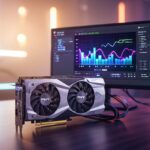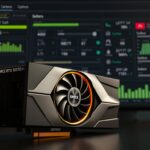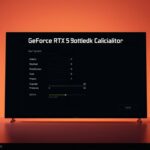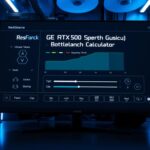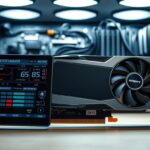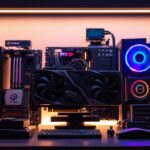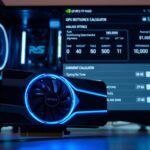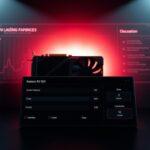Last Updated on July 11, 2025 by Gill
Starting to build your own DIY gaming computer is both thrilling and a bit scary for newbies. But, with a good guide, it’s easy and fun.
Creating a custom gaming PC lets you make it just right for you. This guide will show you how to build a gaming pc that’s perfect for you.

With this guide, you’ll make a strong gaming computer that makes games better. A custom PC is better for gaming, easier to upgrade, and saves money.
Key Takeaways
- Customizing your gaming PC to fit your budget and needs.
- Understanding the importance of a DIY gaming computer.
- Learning the basic steps involved in building a gaming PC.
- Enhancing your gaming experience with a custom-built PC.
- Enjoying the benefits of easier upgrades and cost-effectiveness.
Why Build Your Own Gaming PC
Building your own gaming desktop can save you money and meet your gaming needs. You can pick parts that fit your budget and performance goals. This way, you get a system that’s just right for you.
It’s not just about saving money. Building your own PC lets you create a system that’s perfect for you. Let’s look at the benefits in more detail.
Cost Benefits vs. Pre-built Systems
Building your own gaming PC can save you money compared to buying a pre-built one. When you build a gaming desktop, you skip the extra costs of brand names and pre-assembled systems. Here are some ways you can save:
- You can choose components based on your budget.
- Avoid unnecessary features that increase the cost.
- Upgrade individual parts over time, extending the system’s lifespan.
Customization Advantages
Creating a custom gaming rig means you can customize it a lot. You can pick the CPU, GPU, RAM, and storage that fit your gaming needs best. This ensures your system is optimized for your favorite games.
Essential Tools and Workspace Setup
To assemble a gaming PC smoothly, you need the right tools and a good workspace. A tidy workspace makes the job easier and keeps parts safe from damage.
Required Tools for Assembly
Assembling a gaming PC needs certain tools. You’ll need screwdrivers (Phillips and flathead), cable ties for keeping cables tidy, and anti-static wrist straps or mats. These tools help you work safely and efficiently.
Creating an Ideal Workspace
Setting up a great workspace is more than just a clean area. It’s about reducing static electricity, having good light, and keeping everything organized. Using an anti-static wrist strap and working on a static-free surface protects your parts. Also, bright light makes it easier to see small parts and connectors, making the job less stressful.
Understanding PC Components
Knowing the parts of a gaming PC is key to making smart choices. Each part is important for how well your PC works and plays games.
CPU: The Brain of Your System
The CPU (Central Processing Unit) is in charge of all your computer’s tasks. It’s vital for a gaming PC to run smoothly and handle many tasks at once.
GPU: Graphics Processing Power
The GPU (Graphics Processing Unit) handles graphics, making it crucial for gaming. A top-notch GPU boosts your gaming experience.
Motherboard: The Foundation
The motherboard connects all parts of your PC. It makes sure your CPU and RAM work well together, forming the base of your gaming PC.
RAM: Memory Matters
RAM (Random Access Memory) is for data the CPU uses temporarily. Having enough RAM means your PC can do many things at once without slowing down.
Storage Options: SSD vs. HDD
Deciding between SSD (Solid State Drive) and HDD (Hard Disk Drive) depends on what you need. SSDs are fast, while HDDs give you more storage for less money.
Power Supply: Reliable Energy
The power supply unit powers all your PC’s parts. A good power supply keeps your system running well and protects your parts from damage.
Understanding these parts helps you build a gaming PC that fits your needs and budget.
Budgeting Your Build Gaming PC Project
A well-planned budget is key to a successful custom gaming rig. Knowing how to spend your money on different parts is important. It helps you get the best performance from your gaming PC.
Entry-Level Builds ($500-$800)
Entry-level builds are great for those with a smaller budget. They are perfect for casual gamers or newcomers to PC gaming.
Best Component Choices for Budget Builds
For budget builds, focus on a good CPU and a dedicated GPU. Look for mid-range parts that offer a balance of performance and cost.
Where to Save vs. Where to Spend
Save money on the case and storage. But, spend more on a reliable power supply and enough RAM. This mix ensures your system runs smoothly and can be upgraded later.
Mid-Range Builds ($800-$1500)
Mid-range builds offer better performance. They are good for more challenging games and tasks. You can get better GPUs and faster storage at this level.
High-End Builds ($1500+)
High-end builds are for gaming enthusiasts. They provide top performance with the latest tech. These builds are great for 4K gaming, VR, and extreme overclocking.
| Build Category | Budget Range | Key Components to Invest In |
|---|---|---|
| Entry-Level | $500-$800 | CPU, GPU, RAM |
| Mid-Range | $800-$1500 | High-end GPU, Fast Storage |
| High-End | $1500+ | Latest CPU, High-end GPU, Premium Storage |

Understanding your budget and choosing the right parts is crucial. This way, you can create a build gaming pc that fits your needs without overspending.
Selecting Compatible Components
Building a gaming PC requires choosing parts that work well together. It’s important to make sure each part fits with the others. This ensures your PC runs smoothly and avoids problems during setup.
CPU and Motherboard Compatibility
The CPU and motherboard are key to your gaming PC. They must be compatible. The CPU must fit the motherboard’s socket, and the motherboard must support the CPU’s chipset.
For example, an AMD Ryzen CPU needs a motherboard with an AM4 socket. An Intel Core i9 CPU requires a motherboard with an LGA 1200 socket.
- Check the CPU socket type and ensure the motherboard supports it.
- Verify that the motherboard chipset is compatible with the CPU.
Power Supply Requirements
The power supply unit (PSU) powers all parts of your PC. It’s important to pick a PSU that can handle your build’s power needs. Add up the wattage of the CPU, GPU, RAM, and other parts to find the total power draw.
A PSU with more wattage than needed is best. It allows for future upgrades and prevents overloading.
Key considerations for PSU selection:
- Wattage: Ensure it’s sufficient for your build’s total power draw.
- Efficiency: Look for PSUs with high efficiency ratings (e.g., 80 PLUS Gold).
- Modularity: Modular PSUs can improve cable management.
Case Size and Component Clearance
The case must fit all components well. Think about the size of the motherboard, GPU, CPU cooler, and PSU. Make sure there’s enough space for airflow and cable management.
When picking a case, look at dust filtration, cable management, and aesthetics. A good case improves both performance and looks.
Preparing for Assembly
Starting a DIY gaming computer build requires careful preparation. Make sure your components are unpacked and organized. Also, take steps to avoid static electricity damage.
Unpacking and Organizing Parts
First, unpack all parts from their boxes and bags. It’s important to arrange them in a way that makes sense. This makes it easier to find what you need when you’re building.
Use an organizer box or tray for small items like screws and cables. This keeps everything in order and saves time. It also helps prevent losing important parts.

| Component | Quantity | Notes |
|---|---|---|
| CPU | 1 | Handle with care, avoid touching pins |
| RAM | 2-4 | Ensure compatibility with motherboard |
| Graphics Card | 1 | Check for PCIe compatibility |
Anti-Static Precautions
Static electricity can harm your components. To avoid this, take anti-static precautions. Touch a metal object or wear an anti-static wrist strap to ground yourself.
Work on a non-carpeted, anti-static surface. These steps help protect your components from static damage. This ensures your build goes smoothly.
Step-by-Step Assembly Guide
Building your gaming PC is easy when you break it down. This guide will help you install key parts for a great build.
Installing the CPU
The CPU is the heart of your gaming PC. It’s important to install it right for the best performance.
Proper Alignment and Handling
To install the CPU, align the CPU pins with the socket on the motherboard. Always handle the CPU by its edges to avoid touching the pins.
Common Installation Mistakes
Don’t make mistakes like forcing the CPU into the socket or not using enough thermal paste.
Mounting the CPU Cooler
After putting in the CPU, it’s time to add the CPU cooler. This keeps your CPU at the right temperature.
Secure the cooler firmly to the motherboard with the mounting hardware. Make sure it’s tightly attached for good heat transfer.
Installing RAM
RAM is key for smooth performance. To install RAM, align the notches on the RAM module with the tabs on the DIMM slot.
Press gently until it clicks into place. Make sure the RAM is firmly seated to avoid problems.
Mounting the Motherboard
The motherboard is the base of your gaming PC. To mount it, carefully place it into the case, making sure the stand-offs match the motherboard holes.
Secure the motherboard with screws. Be careful not to overtighten, which can harm the board.
Installing Storage Drives
Storage drives, like SSDs or HDDs, hold your OS and games. To install, connect the drive to the appropriate SATA port on the motherboard.
Secure the drive to the case with screws. Make sure it’s well connected to the motherboard and power supply.
Installing the Graphics Card
The graphics card is vital for gaming. To install, remove any expansion cards from the PCIe slot and push the graphics card in until it clicks.
Secure the graphics card to the case with screws. Connect any power cables from the power supply.
Cable Management Techniques
Effective cable management is key to a well-organized custom gaming rig. Properly managed cables not only improve the aesthetics of your build. They also enhance airflow and reduce dust buildup, leading to better performance and longevity of your components.
Power Supply Connections
A crucial aspect of cable management involves connecting the power supply unit (PSU) to various components. Ensuring that these connections are secure and organized is vital.
Essential Power Connectors
The PSU provides power to critical components via various connectors. These include the 24-pin ATX connector for the motherboard, 8-pin EPS connector for the CPU, and 6-pin or 8-pin PCIe connectors for the graphics card. Understanding the roles of these connectors is essential for a successful gaming PC assembly.
Modular vs. Non-modular Cabling
Modular PSUs offer flexibility by allowing you to connect only the necessary cables, reducing clutter. In contrast, non-modular PSUs have all cables permanently attached, which can lead to a more complex cable management scenario.
Organizing and Routing Cables
After connecting essential components, the next step is to organize and route cables effectively. This involves using cable ties, zip ties, or cable management clips to keep cables tidy and secured against the case.

By routing cables behind the motherboard tray or through designated cable management channels, you can achieve a cleaner build. This not only improves airflow but also makes future upgrades and maintenance easier.
BIOS Setup and Configuration
After building your gaming PC, it’s time to set up the BIOS for the best performance. The BIOS controls your computer’s basic functions. Getting it right ensures your system runs well and efficiently.
Accessing BIOS/UEFI
To get into the BIOS, press a specific key when your computer starts. Common keys are Del, F2, or F12. Newer systems might use UEFI, which is easier to use.
Essential BIOS Settings
Important BIOS settings include the boot order, fan settings, and memory timings. Setting the boot order makes sure your system starts from the right device. Adjusting fan settings helps keep your system cool. Tweaking memory timings boosts performance.
Enabling XMP/DOCP Profiles
Turning on XMP (Extreme Memory Profile) or DOCP (Direct Overclock Profile) can really boost your RAM’s speed. These profiles let your RAM run faster than usual, making your system run better. To turn on XMP/DOCP, go to the memory settings in your BIOS and pick the right profile.
| Setting | Description | Benefit |
|---|---|---|
| Boot Order | Sets the order in which the system checks for bootable devices | Ensures the system boots from the correct device |
| Fan Settings | Allows customization of fan speeds for optimal cooling | Manages system temperatures effectively |
| XMP/DOCP Profiles | Enables higher RAM speeds for improved performance | Enhances overall system performance |
Installing Operating System and Drivers
Now that your gaming PC is built and BIOS is set, it’s time to install the operating system and drivers. This step is key to making your build gaming PC run smoothly.
The first thing to do is make a bootable USB drive. You’ll need to download the operating system ISO file. Then, use a tool like Rufus to make the drive bootable.
Creating a Bootable USB Drive
To make a bootable USB drive, you’ll need a USB stick with at least 8GB of space. You’ll also need a tool like Rufus. Download the Windows ISO file from Microsoft’s official site. Then, follow Rufus’s instructions to create the drive.

Windows Installation Process
With your bootable USB drive ready, plug it into your diy gaming computer and restart. Go back into the BIOS settings and set the USB drive as the first boot device. Save the changes and exit. Your PC will now boot from the USB drive. Just follow the on-screen instructions to install Windows.
Essential Driver Installation
After installing Windows, you need to install the necessary drivers. Go to your motherboard manufacturer’s website to get the latest drivers for your chipset, LAN, and audio. Also, download and install the latest GPU drivers from NVIDIA or AMD’s website, depending on your graphics card.
By following these steps, you’ll have a fully functional operating system and the necessary drivers. You can then start gaming on your newly built PC.
Optimizing Your New Gaming PC
To get the most out of your custom gaming rig, follow these optimization tips. Optimizing your gaming PC is key for a smooth gaming experience.
Graphics Settings for Popular Games
Adjusting graphics settings can greatly change your gaming experience. For popular games, finding the right balance between looks and performance is crucial. Start by lowering settings like shadows, anti-aliasing, and texture quality to see if your frame rates improve.
Monitoring Temperatures and Performance
Keeping an eye on your system’s temperatures and performance is vital. Use software tools to track your CPU and GPU temperatures, as well as your frame rates. High temperatures can lead to throttling, reducing your system’s performance. Make sure your cooling system is good and your case has enough airflow.
Basic Overclocking Considerations
Overclocking can boost your system’s performance, but it needs care. Start with small increments and watch your system’s stability. Remember, overclocking can raise temperatures and power use, so a good cooling system is essential.
Conclusion
Now that you’ve built your gaming PC, it’s time to enjoy it. Building your own PC is rewarding. It gives you a system that fits your gaming needs perfectly.
This guide helped you pick the right parts and put them together. Your new PC is ready for any game, big or small. It’s set to give you an amazing gaming experience.
Keep exploring PC gaming and share your stories. The gaming community loves to help and share. With your new PC, you’re part of a world that loves innovation and creativity.
FAQ
What are the most important components to consider when building a gaming PC?
Key parts for a gaming PC are the CPU, GPU, motherboard, RAM, storage, and power supply. Make sure these parts work well together for the best performance.
How do I ensure my components are compatible with each other?
Check each part’s specs to ensure they match. For example, the CPU must fit the motherboard socket. Also, the RAM and motherboard should be compatible, and the power supply must handle the total power of the components.
What is the difference between SSD and HDD storage, and which should I choose?
SSDs are faster and more reliable than HDDs. For a gaming PC, use an SSD for your OS and games. This will make loading times much faster.
How much should I budget for my gaming PC build?
Budgets for gaming PCs vary from $500 to over $1500. Spend more on the GPU for better gaming. Your budget should match your performance needs.
Can I build a gaming PC without prior experience?
Yes, you can build a gaming PC without experience. Just follow a step-by-step guide and understand the components. Taking care during assembly is key to a successful build.
What are the benefits of building my own gaming PC versus buying a pre-built one?
Building your own PC lets you customize and potentially save money. You can choose high-quality components. It’s also a learning experience and a source of pride.
How do I manage cables effectively in my gaming PC build?
Use cable ties and route cables behind the motherboard tray. Your case may have cable management features. This improves airflow, reduces dust, and makes your build look better.
What is the importance of BIOS configuration, and how do I access it?
BIOS setup is key for hardware settings like boot order and fan settings. Access BIOS by pressing a key (like F2, F12, or DEL) during boot-up, as shown on your screen.
How do I optimize my gaming PC for better performance?
Improve performance by adjusting graphics settings, monitoring temperatures, and considering overclocking. Keep drivers updated and clean your system to ensure optimal performance.
- NVIDIA RTX 6000 Ada Generation 48 GB Bottleneck Calculation - October 17, 2025
- Optimize Your GeForce RTX 5070 Performance with Our Bottleneck Tool - October 2, 2025
- GeForce RTX 5090 Bottleneck Calculator: Optimize Your Setup - October 1, 2025


